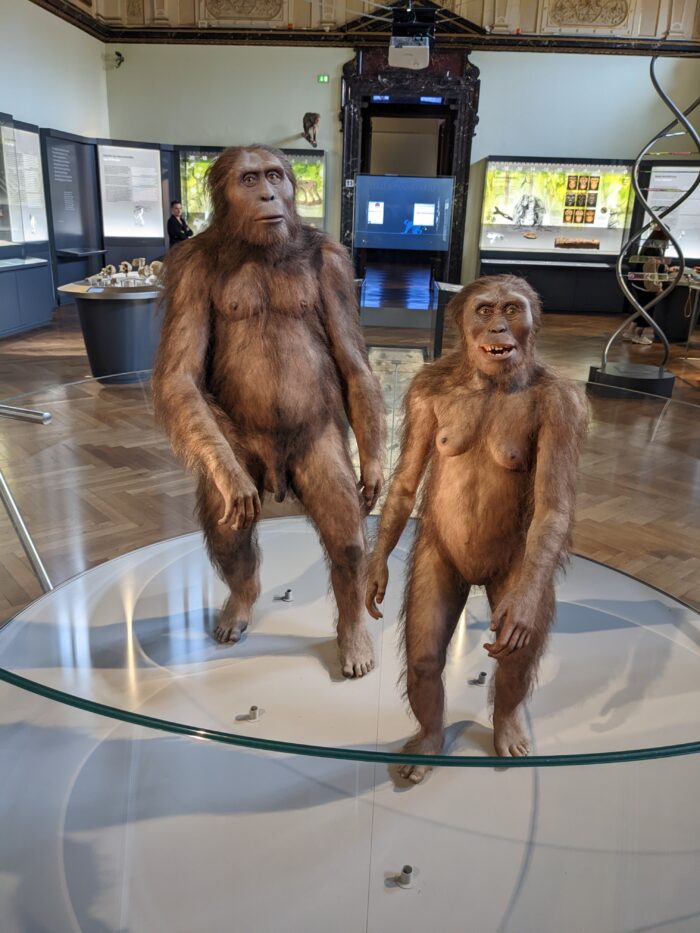
Lucy in the sky with diamonds
Lucy is a female Australopithecus afarensis and is about 25 years old. She lived about 3.2 million years ago. That’s a really long time ago. Her remains were discovered in 1974 during excavations in Ethiopia. She was named after the Beatles song „Lucy in the sky with diamonds“. It was played several times in the research camp on the day of the discovery.1
Lucy became world-famous because fossils of her kind are rare. We regard them as pre-humans, indeed as early, perhaps distant relatives of our species. When she was alive, Lucy was about 1.10 metres / 3.6 ft tall and weighed around 28 kg. That’s about the size of a five-year-old child who weighs as much as an eight-year-old. The males were significantly larger and heavier as you can see in the image above. In biology, such differences between males and females are referred to as dimorphism. With us today, this is much less distinct.2
Walking upright
Lucy may already have used simple stones and sticks as tools.3 But above all, she could walk upright — and was adapted to do so. We can see this in the position of the toes on her feet.4 The human was the first freedman of creation, German philosopher Herder (1744-1803) wrote in his Ideas on the Philosophy of the History of Mankind: „He stands upright.“5 That Herder already had Australopithecines in mind when he wrote these words in 1784 is, of course, impossible. — In Lucy’s time, the size of the forests had already declined significantly. But when danger appeared, she might still have returned to the tops of the trees from time to time.6 Her long arms certainly helped here. She shared her habitat with other kinds of her species.7
For me, Lucy is a wonderful symbol of the adventurous beginnings of humanity.8 I even carry an Australopithecus skull as a tattoo on my left arm as a reminder of nature and origin. It helps me avoid thoughts of a supposed „crown of creation“.
Continue with Homo habilis…

Footnotes / further reading
- Lucy’s Story. In: Website Arizona State University, Institute of Human Origins. URL: https://iho.asu.edu/about/lucys-story. Retrieved May 15, 2023; Barras, C.: Baboon bone found in famous Lucy skeleton. In: New Scientist (April 10, 2015). URL: https://www.newscientist.com/article/dn27325-baboon-bone-found-in-famous-lucy-skeleton/. Retrieved May 22, 2023.
- Johanson, D., Edgar, B.: Lucy und ihre Kinder. Munich: Elsevier, 2006, p. 57-76.
- Johanson, D., Edgar, B.: Lucy und ihre Kinder. Munich: Elsevier, 2006, p. 131-143.
- Johanson, D., Edgar, B.: Lucy und ihre Kinder. Munich: Elsevier, 2006, p. 131-143; Youtube-Video “Walking With Lucy | California Academy of Sciences” (September 19, 2013). URL: https://www.youtube.com/watch?v=xT8Np0gI1dI. Retrieved May 22, 2023.
- v. Herder, J. G.: Ideen zur Philosophie der Geschichte der Menschheit. Erster Teil. Viertes Buch. Der Mensch ist zu feinern Trieben, mithin zur Freiheit organisiert. Riga / Leipzig: Hartknoch, 1784. URL: https://www.textlog.de/5578-2.html. Retrieved June 21, 2023.
- Johanson, D., Edgar, B.: Lucy und ihre Kinder. Munich: Elsevier, 2006, p. 41, p. 57, p. 86-88.
- Johanson, D., Edgar, B.: Lucy und ihre Kinder. Munich: Elsevier, 2006, p. 23.
- Campbell, R. M., Vinas, G., et al.: Team reveals amazing reconstructions of our ancestors to correct mistakes of the past. In: Frontiers Science News (February 26, 2021). URL: https://blog.frontiersin.org/2021/02/26/soft-tissue-reconstruction-human-evolution-early-hominins-art-science-collaboration-quantitative-methods-ensure-accurate-visual-represetations/. Retrieved May 22, 2023.